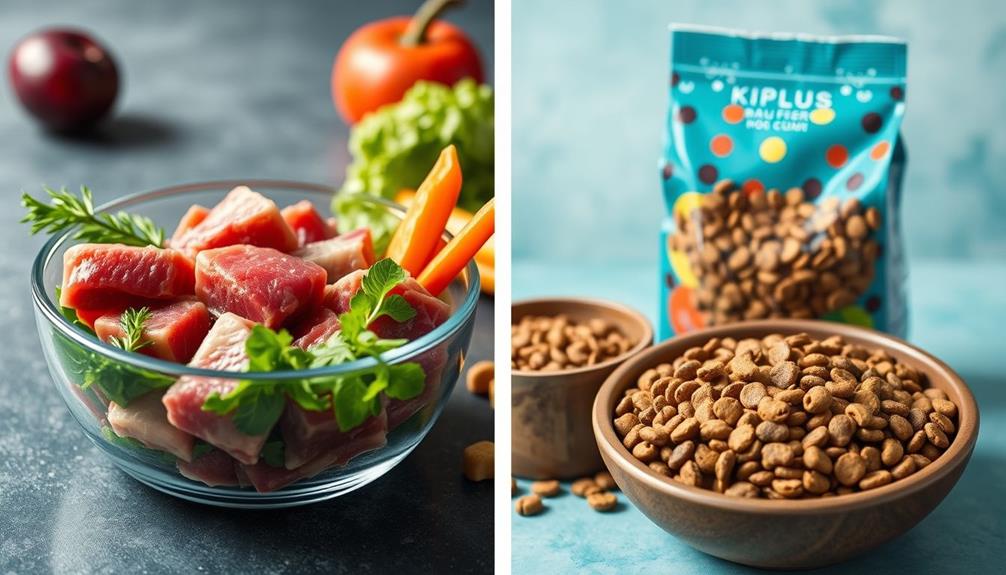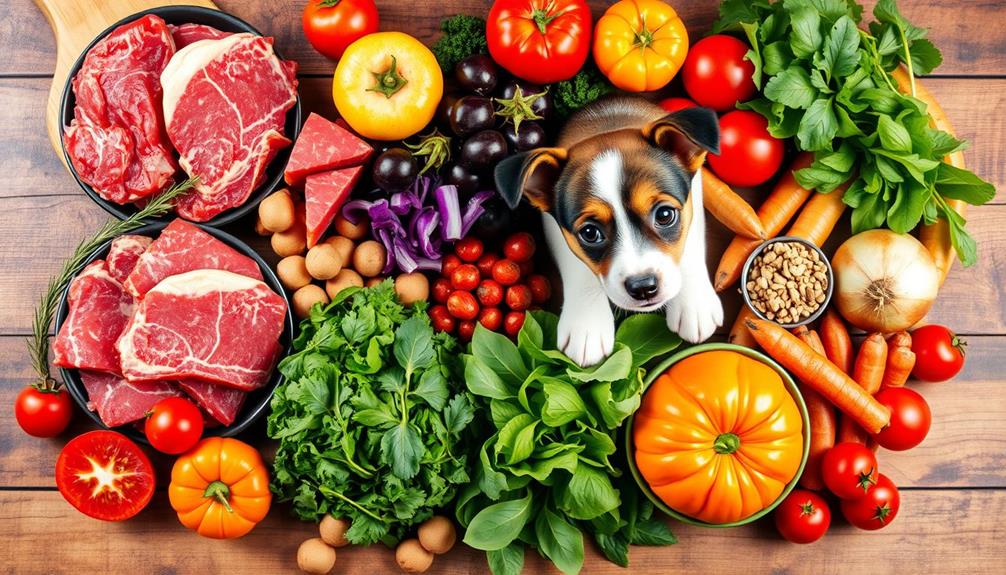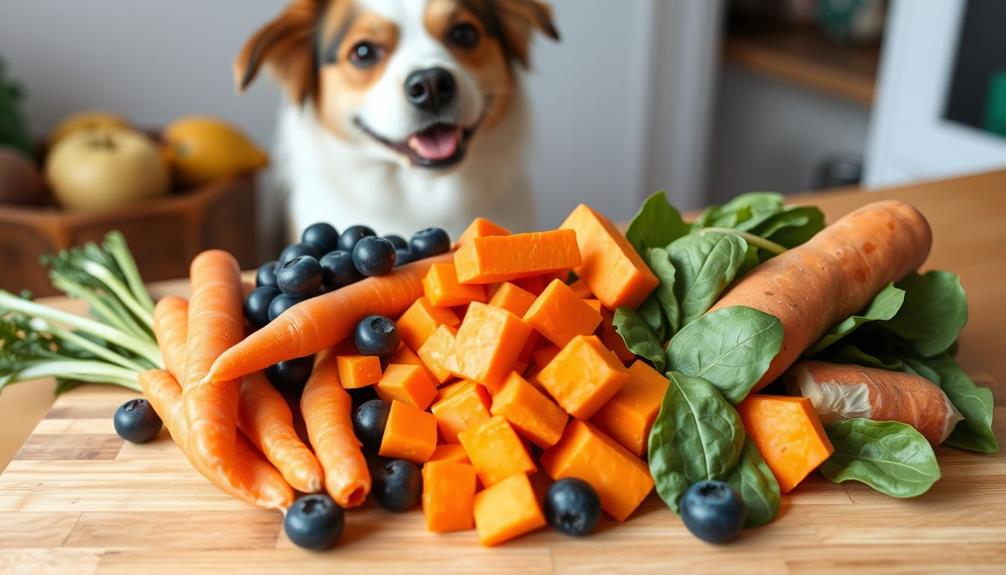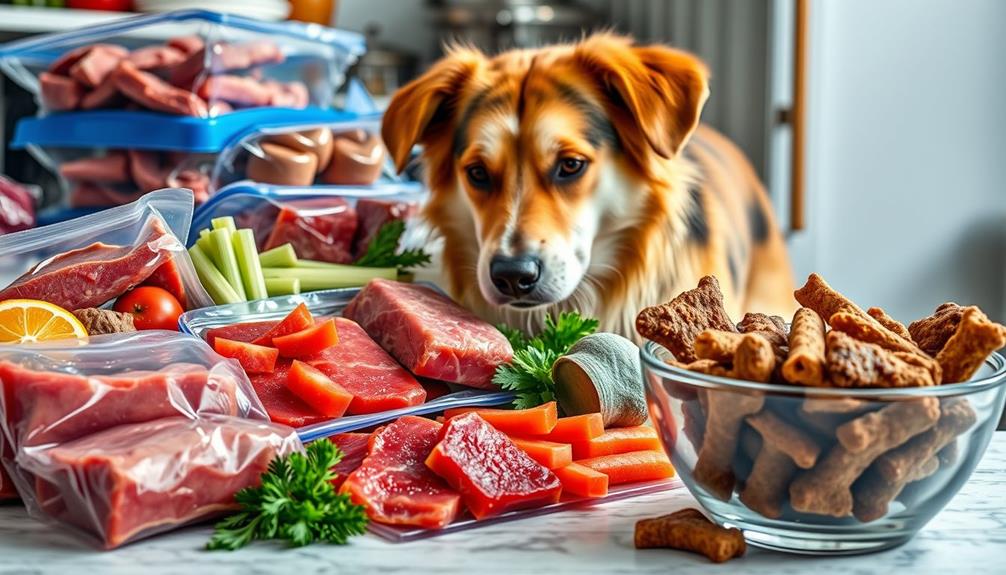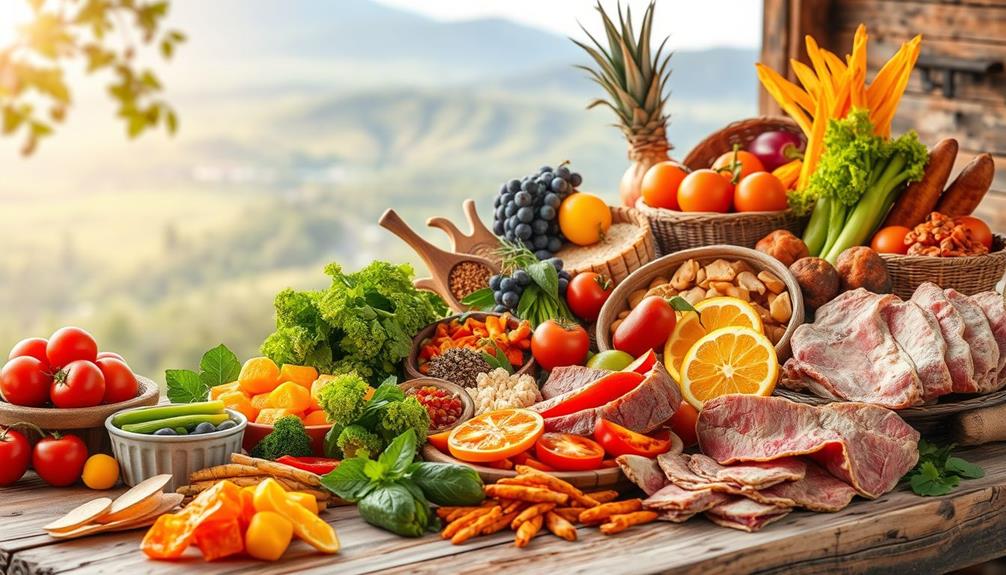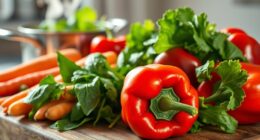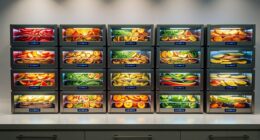You can switch your dog from a raw food diet to kibble, but it takes planning and caution. Start the shift slowly, mixing 75% raw food with 25% kibble for a few days, then gradually increase the kibble. Keep an eye on your dog's digestion and overall behavior; note any signs of upset or allergies. Selecting high-quality kibble that meets your dog's nutritional needs is essential. Don't forget to take into account your dog's age and activity level when choosing food. There's more you should know to make the shift smooth and healthy for your furry friend.
Key Takeaways
- Gradually transition from raw food to kibble by starting with a 75% raw and 25% kibble mix to avoid digestive upset.
- Monitor your dog's digestive health, energy levels, and behavior for any adverse reactions during the transition.
- Choose high-quality kibble with meat as the primary ingredient and check for essential vitamins and minerals.
- Be aware of potential nutritional imbalances from raw diets and ensure the kibble provides complete nutrition for your dog's needs.
- Consult your veterinarian for personalized advice and regular health assessments throughout the dietary change.
Myths About Mixing Diets
Many dog owners often worry about mixing raw food and kibble, believing it can lead to digestive issues. This is a common misconception.
In reality, dogs' digestive systems are quite capable of handling both types of food simultaneously, especially when introduced gradually. Some people think mixing raw food and kibble encourages bad bacteria growth, but proper handling and storage effectively mitigate these concerns. Additionally, providing healthy dog snacks can help ease the shift by keeping your dog engaged and satisfied.
You might also hear that raw and kibble are too different to digest together. This idea doesn't hold up, as dogs' digestive enzymes efficiently break down both food types, ensuring nutrient absorption.
In fact, incorporating even a small percentage of raw food—around 25%—can enhance your dog's nutritional intake and overall health.
As you shift your dog from a raw diet for dogs to kibble, it's crucial to monitor for any adverse reactions. Individual dogs may respond differently to this switch, but that's not inherently due to mixing diets.
Understanding these myths can help you feel more confident in your feeding choices, knowing that mixing raw food and kibble can be done safely with the right approach.
Understanding Raw Food Vs. Kibble
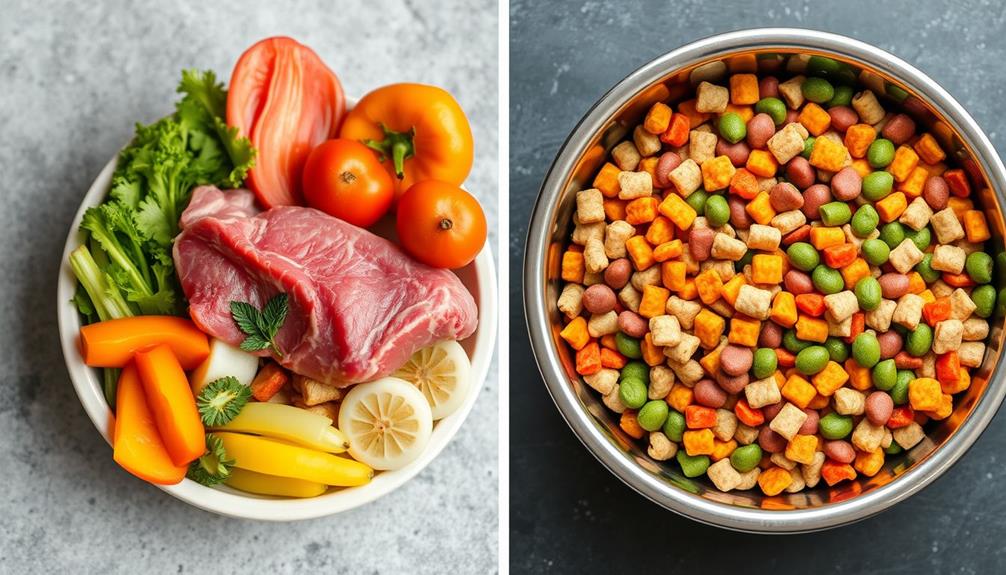
When it comes to choosing the right diet for your dog, it's important to understand the differences between raw food and kibble. Raw food diets typically consist of uncooked ingredients like meats, bones, fruits, and vegetables, while kibble is commercially produced dry food containing grains and meat by-products.
The nutritional balance between the two can vary; raw diets often provide fresher, more natural ingredients, whereas kibble offers convenience and a longer shelf life due to preservatives. Additionally, the choice of ingredients and preparation methods can greatly impact your dog's overall health, similar to how aftercare essential is vital for piercings to prevent complications.
One major aspect to take into account is digestive health. Kibble can promote dental health through its crunching action, aiding in plaque reduction, a benefit that raw diets may lack.
If you're thinking about switching from raw to kibble, it's important to pay attention to your dog's nutritional needs, as kibble usually has less moisture than raw food. During this change, monitor your dog's health closely. Abrupt changes in diet can lead to gastrointestinal upset, making a gradual shift necessary to minimize digestive issues.
Benefits of Kibble

Kibble's convenience and balanced nutrition make it a popular choice among dog owners. One of the key benefits is its easy storage and serving; you won't need to worry about refrigeration, and kibble has a longer shelf life than raw food. This means you can keep your pup's meals fresh without the hassle.
Kibble often comes in various flavors and formulations, catering to different dietary needs, including weight management and specific health issues. Additionally, understanding financial considerations for elderly care can help pet owners budget for their furry friends' needs.
Moreover, many commercial kibble brands are fortified with essential vitamins and minerals, ensuring your dog gets a balanced diet that addresses common nutritional gaps. This can be especially beneficial if you're concerned about meeting your dog's dietary requirements.
Another significant advantage is the cost-effectiveness of kibble. It provides a nutritionally complete diet at a lower price point than raw feeding, making it a practical choice for many pet owners.
Risks of Raw Diets

When considering a raw diet for your dog, you need to be aware of the risks involved.
Bacterial contamination from pathogens like Salmonella and E. coli can pose serious health threats to both your pet and your family.
Additionally, if the diet isn't properly balanced, it could lead to nutritional imbalances that might harm your dog's overall health.
It's also important to note that, similar to cold medications overview, the effectiveness and safety of raw diets can vary, making it essential to consult with a veterinarian before making any dietary changes.
Bacterial Contamination Risks
Switching your dog from a raw diet to kibble involves understanding the potential risks associated with feeding raw food, particularly the dangers of bacterial contamination. Raw diets can introduce harmful pathogens like Salmonella and E. coli, which pose risks not only to pets but also to their human handlers. Studies show that 15-30% of raw meat samples may harbor these bacteria, emphasizing the need for proper handling and hygiene.
| Risk Factor | Description | Mitigation Strategy |
|---|---|---|
| Bacterial Contamination | Pathogens can affect both dogs and humans. | Source high-quality raw food. |
| Improper Storage | Incorrect thawing/storage can lead to bacterial growth. | Always follow food safety practices. |
| Compromised Immune Systems | Dogs with health issues face higher risks of severe illness. | Monitor your dog's health closely. |
To minimize risks, verify you're using high-quality raw food from reputable suppliers and adhere to strict food safety practices during preparation and feeding. By being vigilant about these factors, you can help protect both your dog and your family from the potential dangers of bacterial contamination in raw diets.
Nutritional Imbalance Concerns
Raw diets can lead to significant nutritional imbalances if they aren't properly formulated. Many homemade raw diets often lack essential nutrients like calcium, phosphorus, and certain vitamins important for your dog's overall health. If you don't include a variety of protein sources and necessary supplements, deficiencies can arise, putting your dog's well-being at risk.
Additionally, some pet owners may overlook the importance of a balanced diet, which could also include beneficial supplements like essential oils for wellness that may support overall health.
When shifting your dog from a raw diet to kibble, you need to be mindful of potential digestive upset. Kibble has a different nutrient profile and digestibility, so your pup may require gradual adjustments to adapt smoothly. This sudden change can stress their digestive system, leading to discomfort.
Additionally, the risk of bacterial contamination in raw meats poses health concerns not just for your dog but also for you and your family. Raw diets can expose your pet to harmful bacteria like Salmonella and E. coli, increasing the potential for illness.
While raw bones are often included in these diets, they can splinter and cause serious internal injuries or blockages. To keep your dog healthy, it's essential to evaluate these nutritional imbalances and health risks before sticking with a raw diet.
Transitioning Process Steps
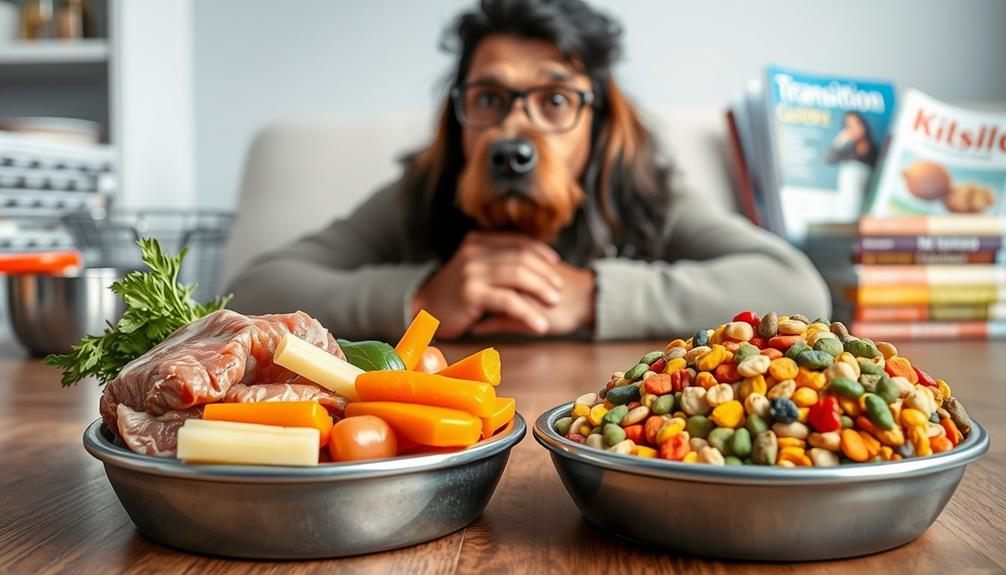
Shifting your dog's diet from raw food to kibble requires a careful approach to guarantee their comfort and health.
Begin the altering process steps by mixing 75% raw food with 25% high-quality kibble for the first few days. This gradual change helps prevent digestive upset, similar to how proper diet is essential for small pets.
As your dog adapts, slowly increase the kibble portion while decreasing the raw food over 7-10 days.
It's vital to monitor your dog's response closely during this period. Keep an eye out for any signs of digestive issues or changes in energy levels, as well as potential allergic reactions. If you notice anything concerning, don't hesitate to consult with a veterinarian. They can provide personalized guidance based on your dog's specific health and nutritional needs.
Consistency is key during this alteration. Stick to a regular feeding schedule, and make certain the kibble you choose is of high quality and fortified with essential nutrients.
Monitoring Your Dog's Response

As you switch your dog from raw food to kibble, keep a close eye on their digestive health for any signs of upset, as changes in diet can impact their overall well-being.
Watch for changes in energy levels and behavior, as these can signal how well they're adjusting to the new diet.
It's important to remember that monitoring your dog's normal frequency ranges can help you identify any potential digestive issues.
Observing Digestive Health
Monitoring your dog's digestive health during the change to kibble is crucial to secure a smooth adjustment. During the initial days of the shift, closely watch for any signs of digestive upset, such as vomiting, diarrhea, or changes in stool consistency.
It's best to introduce kibble gradually, starting with a small percentage mixed into the raw food. This approach helps your dog's digestive system adapt and minimizes gastrointestinal issues. Just as individuals with BPD may experience intense emotional responses to changes in their environment, dogs can also react strongly to dietary changes.
While you're observing their digestive health, keep an eye on your dog's energy levels and overall behavior. Changes in diet can affect their health and mood, which may indicate how well they're adjusting to the new food.
Additionally, be vigilant for any allergic reactions, like itching or skin irritations, which could arise from new ingredients in the kibble that weren't present in their raw diet.
To effectively monitor this shift, maintain a log of your dog's eating habits and any adverse reactions. This record will provide valuable insights into their digestive health and help you assess the success of the dietary change.
With careful observation and attention, you can make sure your dog thrives on their new kibble diet.
Energy Level Changes
Keeping an eye on your dog's energy levels during the change to kibble is essential for understanding how well they're adjusting. Dietary changes can greatly impact their vitality, especially in the first few days. A drop in energy might indicate the kibble isn't meeting their nutrient needs, so you may need to reconsider the formulation or brand.
To effectively monitor your dog's energy levels, consider using the following tracking table:
| Day | Energy Level (1-10) | Notes on Behavior |
|---|---|---|
| Day 1 | ||
| Day 2 | ||
| Day 3 | ||
| Day 4 | ||
| Day 5 |
Keep an eye out for any changes in their enthusiasm for play and exercise. If you notice a considerable drop, it could suggest adverse reactions to the new kibble. Regularly logging these observations will provide insights into how well your dog is adapting and help you make necessary adjustments to their diet. Remember, maintaining their energy levels is essential to their overall well-being.
Behavioral Adjustments
During the changeover from raw food to kibble, it's essential to watch for any behavioral changes in your dog that could indicate how well they're adjusting. Monitor for signs of digestive upset, such as vomiting or diarrhea, as these may occur during the adjustment period.
It's also important to take into account that just as with humans, dietary changes can affect overall health, so be observant of potential long-term effects like breast cancer symptoms in relation to diet. If you notice a decrease in your dog's appetite or energy levels, it might signal dissatisfaction with the new diet or potential health issues.
Additionally, keep an eye out for allergic reactions, which could show up as skin irritations or itching. If these symptoms arise, consult your veterinarian promptly.
Don't forget to track your dog's stool consistency; changes here can reveal how well they're adapting to the kibble and whether it meets their digestive needs.
You might also see some behavioral changes, like increased begging or food aggression, as your dog navigates this new diet.
Patience is key during this shift. Gradually adjusting feeding practices can help ease your dog into the new kibble routine. By staying observant and responsive to these signs, you'll facilitate a smoother switch and a happier, healthier pup.
Long-Term Dietary Considerations

Shifting your dog from raw food to kibble requires careful contemplation of their long-term dietary needs. It's imperative to guarantee your dog maintains balanced nutrition that supports their overall health, particularly focusing on their individual requirements as they age.
Here are three significant factors to reflect on:
1. Dietary Requirements: Assess your dog's age, weight, and activity level. These factors will influence their nutritional quality and help you select a kibble that meets their specific needs.
Incorporating a balanced diet rich in fruits, vegetables, and whole grains can further enhance their health.
2. Individual Preferences: Pay attention to your dog's likes and dislikes. If they prefer raw food, they might resist the switch. A gradual change can help ease this adjustment.
3. Health Risks: Regular veterinary check-ups are essential during this change. They monitor any health risks and help you adjust your dog's diet as necessary, especially if there are pre-existing health conditions.
Maintaining a balance between convenience, cost, and nutritional quality is critical for your dog's long-term health.
Staying informed about potential recalls or safety issues with kibble brands can also prevent health risks associated with contaminated products.
Prioritizing these factors will help guarantee your dog thrives on their new diet.
Selecting Quality Kibble

When you're selecting quality kibble, start by evaluating the ingredient list; meat should always come first.
You'll want to make certain the kibble provides a balanced nutrition profile, packed with essential nutrients for your dog's health.
Don't forget to research the brand's reputation and safety practices to guarantee you're making a wise choice.
Ingredient Quality Assessment
Choosing the right kibble for your dog can be a challenging task, but focusing on ingredient quality makes a significant difference. When shifting from a raw diet to processed kibble, prioritize brands that emphasize whole food ingredients.
Here are three key points to reflect on:
- Named Ingredients: Look for kibble that lists specific meats, like chicken or beef, rather than vague terms such as "meat by-products" or "animal meal." This guarantees you're providing quality food for your dog.
- Balanced Nutrition: Confirm the kibble contains a balanced mix of protein, healthy fats, and carbohydrates tailored to your dog's nutritional needs based on their breed, age, and activity level.
- Essential Nutrients: Check for the presence of crucial vitamins and minerals, particularly omega-3 and omega-6 fatty acids, which offer health benefits like improved skin health and overall well-being.
Additionally, investigate the sourcing and manufacturing practices of the kibble brand.
Choose options free from artificial preservatives, colors, and flavors, favoring natural preservation methods instead.
Nutritional Balance Evaluation
Evaluating the nutritional balance of kibble is vital for your dog's health as you shift from a raw diet. Start by prioritizing high-quality protein sources as the first ingredient. This guarantees that your dog receives the necessary nutrients tailored to their specific needs.
Avoid kibble with fillers like corn, soy, and artificial additives, as these offer little nutritional value and can trigger allergies in some dogs.
Next, look for kibble that's fortified with essential vitamins and minerals, such as omega fatty acids, calcium, and phosphorus. These nutrients support your dog's overall health and well-being.
It's also important to take into account your dog's life stage—puppy, adult, or senior—since their nutritional requirements differ greatly, impacting growth, maintenance, and aging.
Brand Reputation Research
Finding the right kibble goes beyond just checking the nutritional label; it involves understanding the brand's reputation. A reputable brand guarantees quality and safety, which is essential for your dog's health.
Here are three key factors to reflect on:
- Ingredient Quality: Look for brands that share transparent information about their ingredient sourcing. High-quality protein sources and minimal fillers can greatly enhance your dog's nutrition.
- Recalls History: Investigate the brand's recall records. Established brands with a clean recall history are generally more trustworthy, reflecting their commitment to safety.
- Customer Feedback: Review customer feedback and ratings to gauge other pet owners' experiences. This can offer insight into palatability and any potential digestive issues that may arise.
Additionally, evaluate the nutritional formulations offered by the brand. Confirm they align with your dog's specific dietary needs, including age, breed, and any health conditions.
Customizing Diet for Your Dog
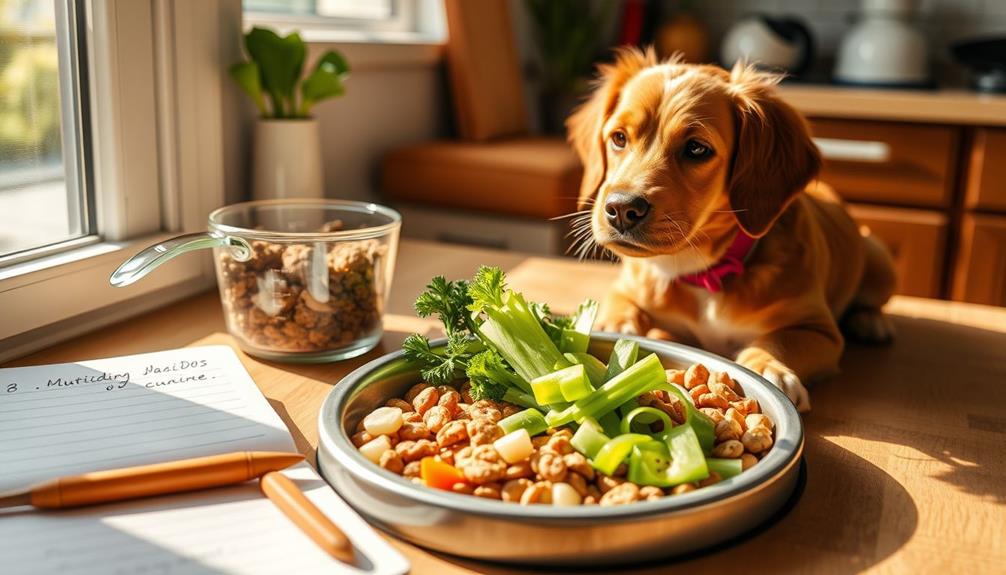
When customizing your dog's diet, it's vital to take into account their unique nutritional needs, which can differ based on factors like age, weight, breed, and any health conditions.
Shifting from raw food to kibble means guaranteeing balanced nutrition, so start by selecting high-quality kibble that complements the raw diet's benefits. This way, your dog can receive a well-rounded intake of nutrients.
To ease the shift, gradually mix the kibble with raw food. This approach helps your dog adapt and allows you to monitor their reaction to the new diet.
Pay close attention to changes in energy levels, stool consistency, and overall health during this period. It's important to adjust the diet based on these observations, as every dog responds differently to dietary changes.
Don't hesitate to consult with a veterinarian for personalized guidance. They can help you understand your dog's specific dietary needs and make sure that the customized diet promotes ideal health.
Common Concerns and Misconceptions

Changing your dog from raw food to kibble can raise numerous concerns and misconceptions among pet owners. It's vital to address these common concerns to guarantee a smooth changeover for your furry friend.
- Digestive Issues: Many believe that switching suddenly can lead to severe digestive problems. In reality, dogs can adapt to different diets with a gradual change, minimizing any potential distress.
- Nutritional Deficiencies: Some worry that kibble lacks necessary nutrients. However, high-quality kibbles are fortified with vitamins and minerals, providing balanced nutrition tailored to your dog's needs.
- Bacterial Contamination: There's a misconception that kibble carries the same risk of bacterial contamination as raw food. Kibble is typically cooked and processed, greatly reducing this risk.
It's important to monitor your dog's health during the changeover and consult a veterinarian for tailored advice.
Frequently Asked Questions
Can You Switch a Dog From Raw Food to Kibble?
Yes, you can switch your dog from raw food to kibble. Just make the change gradual over 7-10 days, monitor their reactions, and consult your vet to guarantee it suits their health needs.
How to Transition Dog From Fresh Food to Kibble?
To shift your dog from fresh food to kibble, start by mixing a small amount of kibble with their food. Gradually increase the kibble ratio over a week, monitoring for any digestive changes.
Can I Feed My Dog Kibble in the Morning and Raw at Night?
You'll find feeding your dog kibble in the morning and raw at night works well. Just keep an eye on how they respond, and gradually introduce the raw food to avoid any digestive issues.
Do Dogs Detox When Switching to Raw?
Dogs don't detox when switching to raw food. If you notice changes in their stool or energy, it's likely due to dietary adjustments. Gradually introducing new foods can help ease any digestive discomfort.
Conclusion
Switching your dog from raw food to kibble can be a smooth process if you take the right steps. Remember, "slow and steady wins the race"—transition gradually to avoid digestive upset. Focus on selecting high-quality kibble that meets your dog's nutritional needs, and always keep an eye on their health. With the right approach, you can guarantee your furry friend thrives on their new diet while enjoying the benefits of kibble.

